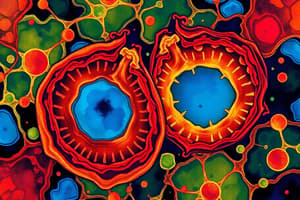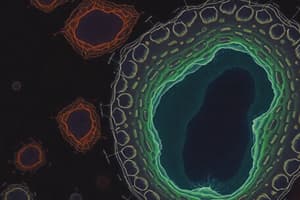Podcast
Questions and Answers
What is a tissue?
What is a tissue?
A group of cells that are similar in structure and/or work together to achieve a particular function.
Which type of cells in human beings is responsible for movement?
Which type of cells in human beings is responsible for movement?
- Vascular tissues
- Muscle cells (correct)
- Nerve cells
- Blood cells
What type of organisms have cells that perform all basic functions?
What type of organisms have cells that perform all basic functions?
Unicellular organisms
Plants and animals have the same type of tissues.
Plants and animals have the same type of tissues.
In plants, tissues that divide throughout their life are called ______.
In plants, tissues that divide throughout their life are called ______.
How do the growth patterns differ between plants and animals?
How do the growth patterns differ between plants and animals?
Which of the following statements is true regarding plant and animal tissue?
Which of the following statements is true regarding plant and animal tissue?
What are the two types of plant tissues based on their dividing capacity?
What are the two types of plant tissues based on their dividing capacity?
In unicellular organisms, a single cell performs all basic ______.
In unicellular organisms, a single cell performs all basic ______.
Muscle cells contract and relax to cause ______.
Muscle cells contract and relax to cause ______.
In plants, vascular tissues conduct food and water from one part of the plant to other ______.
In plants, vascular tissues conduct food and water from one part of the plant to other ______.
Multicellular organisms show ______ of labour.
Multicellular organisms show ______ of labour.
Supportive tissue in plants generally has ______ cells.
Supportive tissue in plants generally has ______ cells.
Animal tissues are mostly ______ compared to plants.
Animal tissues are mostly ______ compared to plants.
The growth in plants is limited to certain ______.
The growth in plants is limited to certain ______.
Cell growth in animals is more ______.
Cell growth in animals is more ______.
A group of cells that are similar in structure and/or work together to achieve a ______ function forms a tissue.
A group of cells that are similar in structure and/or work together to achieve a ______ function forms a tissue.
The structural organisation of organs and organ systems is more specialised in ______ animals.
The structural organisation of organs and organ systems is more specialised in ______ animals.
Flashcards are hidden until you start studying
Study Notes
Living Organisms and Cells
- All living organisms consist of one or more cells.
- Unicellular organisms, like Amoeba, rely on a single cell for all functions including movement, feeding, gas exchange, and waste elimination.
- Multicellular organisms have millions of cells, many of which are specialized for distinct functions.
- Specialized cells enhance efficiency in performing specific tasks in multicellular organisms.
Types of Specialized Cells in Humans and Plants
- Human body:
- Muscle cells enable movement through contraction and relaxation.
- Nerve cells transmit messages throughout the body.
- Blood transports oxygen, nutrients, hormones, and waste.
- Plant body:
- Vascular tissues facilitate the transportation of food and water across different parts of the plant.
Definition and Function of Tissues
- Tissues consist of groups of similar cells that work together for a common function.
- Tissues are structured and arranged to maximize functional efficiency.
- Examples include blood (connective tissue), phloem (vascular tissue), and muscle (muscle tissue).
Comparison of Plant and Animal Tissues
-
Movement
- Plants are stationary and require supportive tissues, which usually contain dead cells.
- Animals are mobile, consuming more energy, resulting in predominantly living tissues.
-
Growth Patterns
- Plant growth occurs in specific regions, characterized by meristematic tissues that continuously divide.
- Animal growth is more uniform, with no distinct dividing regions, leading to uniform cell growth.
-
Organ Structure and Specialization
- Complex animals possess more specialized organ structures compared to plants.
- Variations in organ system design are adaptations to differing lifestyles: sedentary (plants) versus active (animals).
Conclusion
- The structural and functional differences between plant and animal tissues highlight their adaptations to their respective environments and modes of life.
Living Organisms and Cells
- All living organisms consist of one or more cells.
- Unicellular organisms, like Amoeba, rely on a single cell for all functions including movement, feeding, gas exchange, and waste elimination.
- Multicellular organisms have millions of cells, many of which are specialized for distinct functions.
- Specialized cells enhance efficiency in performing specific tasks in multicellular organisms.
Types of Specialized Cells in Humans and Plants
- Human body:
- Muscle cells enable movement through contraction and relaxation.
- Nerve cells transmit messages throughout the body.
- Blood transports oxygen, nutrients, hormones, and waste.
- Plant body:
- Vascular tissues facilitate the transportation of food and water across different parts of the plant.
Definition and Function of Tissues
- Tissues consist of groups of similar cells that work together for a common function.
- Tissues are structured and arranged to maximize functional efficiency.
- Examples include blood (connective tissue), phloem (vascular tissue), and muscle (muscle tissue).
Comparison of Plant and Animal Tissues
-
Movement
- Plants are stationary and require supportive tissues, which usually contain dead cells.
- Animals are mobile, consuming more energy, resulting in predominantly living tissues.
-
Growth Patterns
- Plant growth occurs in specific regions, characterized by meristematic tissues that continuously divide.
- Animal growth is more uniform, with no distinct dividing regions, leading to uniform cell growth.
-
Organ Structure and Specialization
- Complex animals possess more specialized organ structures compared to plants.
- Variations in organ system design are adaptations to differing lifestyles: sedentary (plants) versus active (animals).
Conclusion
- The structural and functional differences between plant and animal tissues highlight their adaptations to their respective environments and modes of life.
Studying That Suits You
Use AI to generate personalized quizzes and flashcards to suit your learning preferences.




